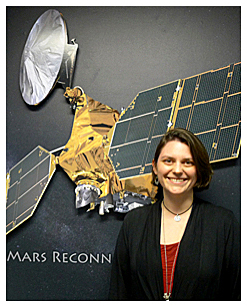Sarah Milkovich
Investigation scientist, Jet Propulsion Laboratory
 What’s your current position and what does your research focus on?
What’s your current position and what does your research focus on?
I’m currently the HiRISE investigation scientist at NASA’s Jet Propulsion Laboratory. Part of my time is spent doing research into the Martian polar layered deposits, which are kilometers-thick sheets of
water ice and dust at both poles.
However, most of my time is spent with the spacecraft engineering team and representatives from the other instrument teams, working to keep MRO operating smoothly and keeping the lines of communication
open between the HiRISE team, the engineering teams, and the spacecraft management. My job is to be the HiRISE team’s eyes and ears at JPL while the rest of the team concentrates on operating the
instrument from the University of Arizona.
What got you interested in planetary science?
A combination of childhood interests in geology and astronomy definitely was part of it, but also watching specials on TV about spacecraft (like NOVA on PBS) where I got to see the team of scientists
and engineers that operated the spacecraft. I wanted to someday be on a team with those people, and now I am!
Why is your subject of study/research important to you?
The polar layered deposits contain the record of recent (i.e., millions of years) climate change on Mars, just like ice sheets do on Earth, but we haven’t yet figured out how to translate that record.
We think that the cyclic variations in Mars’ orbit cause cyclic variations in the climate, which in turn create the polar layered deposits, but we haven’t been able to fill in the details. We need to understand
how a particular climate at a particular time formed an individual layer at the pole in order to put the whole picture together, and then we can take that to understand how some of the other icy
features we see around the planet fit in.
My real passion is spacecraft operations, though. A large part of my job is to act as a bridge to bring science and engineering together, which is hugely important for a successful mission. I love
the team environment, and I love working to get the most science we can out of our spacecraft.
What would you suggest to a young person to study if he/she is interested in planetary science?
The beauty of planetary science is that it is a very interdisciplinary field; people come in with a wide range of interests. Math, physics and geology are great things to study if you are interested in planetary science.
You can read more about Sarah at NASA’s Solar System Exploration page.
About HiRISE
The HiRISE camera onboard the Mars Reconnaissance Orbiter is the most powerful one of its kind ever sent to another planet. Its high resolution allows
us to see Mars like never before, and helps other missions choose a safe spot to land for future exploration.
NASA’s Jet Propulsion Laboratory, a division of the California Institute of Technology in Pasadena, Calif., manages the Mars Reconnaissance
Orbiter for NASA’s Science Mission Directorate, Washington. Lockheed Martin Space Systems is the prime contractor for the project and
built the spacecraft. The HiRISE camera was built by Ball Aerospace & Technologies Corp. and is operated by the
University of Arizona.
 What’s your current position and what does your research focus on?
What’s your current position and what does your research focus on?